Wednesday, May 31, 2006
Grappling Tip of the Week - Kneebarring the Top or Bottom Leg?
There is also an excellent page on the main site titled "Kneebar Leglock Q & A" for more information.
Real-life "Fight Club" Participants Bruised, Bloodied
... bloodied and bruised, they limp back to their desks in the morning.This is all well and good for us grown adults, who should be mature enough to know and assume all the inherent risks of activities like this but...
"When you get beat down enough, it becomes a very un-macho thing," said Shiyin Siou, 34, a Santa Clara software engineer and three-year veteran of the clandestine fights. "But I don't need this to prove I'm macho -- I'm macho enough as it is."
Inspired by the 1999 film "Fight Club," starring Brad Pitt and Ed Norton, underground bare-knuckle brawling clubs have sprung up across the country as a way for desk jockeys and disgruntled youths to vent their frustrations and prove themselves.
"This is as close as you can get to a real fight, even though I've never been in one," the soft-spoken Siou said.
In recent months, police in New Jersey and Pennsylvania have broken up fight clubs involving teens and preteens who posted videos of their bloody battles online.Dr. Helen's point of view is that, "Sex used to be forbidden and people went underground to do it--now sex is advocated everywhere--even college campuses hand out free condoms. But now the forbidden fruit in our society is violence and it has gone underground." She believes that traditional masculinity has become so un-PC (politically correct), that the repressed aggression has no outlet. She goes on, "The aggression was innate to begin with but it was never channeled, and instead was stomped out of them in the culture as something wicked, immoral and "male." Perhaps these fight clubs are the new male ritual, like in the olden days when boys went through rituals to become men. The schools and culture have attempted to squash whatever maleness is left in today's men and all they are left with (besides football which is now banned at my daughter's elementary school) are a few underground clubs to artificially practice their manhood. Wouldn't it be better for our culture to accept and teach boys how to sublimate and deal with violence when they are younger so they do not have to grow up to be men so desperate to prove themselves that a broken rib and a thrashing at an "underground" fight club is the only way to prove their manhood?"
Earlier this month in Arlington, Texas, a high school student who didn't want to participate was beaten so badly that he suffered a brain hemorrhage and broken vertebrae. Six teenagers were arrested after DVDs of the fight appeared for sale online.
I tend to agree. Martial arts are another way I keep sane. Sam once said that he always felt best after we went toe to to for our 90 minutes every week. Same here. I've commented before on how much I love the contact, the bone on flesh contact, and even the near misses that are part of the territory. That may change as I grow older, but for now...
Read the rest.
Tuesday, May 30, 2006
Fields of Friendly Strife
 "Upon the fields of friendly strife
"Upon the fields of friendly strifeAre sown the seeds
That, upon other fields, on other days
Will bear the fruits of victory."
Gen. Douglas MacArthur wrote this while superintendent of the U.S. Military Academy at West Point, New York, 1919–1922, and had them engraved over the entrance to the gymnasium. Why there?
MacArthur understood that training is the time to challenge yourself-to get it right. The hours of sweat an toil in the training environment are when you need to concentrate on perfection, so that when you are competing, or more importantly, defending yourself or your loved ones, you are good enough.
Making the Transition from Boxing to MMA Gloves
- Boxing gloves (esp. 16-ounce training gloves) tend to allow you to (unrealistically) hit harder to well-protected areas than you could realistically do without them, for example, a punch to the forehead is no problem, nor a jab to an elbow. In reality, both of those targets with a clenched fist would incapacitate the puncher, not the punchee. MMA gloves provide minimal protection for the hand, and don't really increase the likelihood of damage to the recipient, so they teach you to punch to better (softer) targets, or else!
- Boxing gloves provide an unrealistic defense due to their size (they can serve as a shield), and the padding effect. Blows can be blocked by just raising the gloves, when, in reality, that would result in an injured blocking hand. Empty-hand (or MMA gloves) teaches us to slip, parry, elbow block, check, and jam so that we don't have to take damage.
- Boxing gloves don't allow for grabbing, other than the clinch. MMA gloves allow us to grab and clinch better, reducing the chance of getting hit by a strike, and are required if you're going to use most grips and wrist locks.
- Boxing gloves, while removing the inhibition to hitting hard, also slow you down. Even 8-12 ounce fight gloves a bulky compared to the little 4 oz. MMA-style. MMA gloves provide a better guage of the speed you may face versus a fast opponent on the street.
- Boxing gloves take away the precise aim that's required for accurate striking. I remember the first time we sparred with MMA gloves, and I was able to throw a vertical fist between the guard of my opponent and land to the body. Ditto with an uppercut between the arms. In both cases, boxing gloves would've prevented me from using the openings.
A caveat: Without boxing gloves, you have thumbs. Thumbs are, "the shortest thickest digit of the human hand, located next to the forefinger," according to Microsoft's Encarta. They are also vulnerable when punching. You must tuck those thumbs down and in to avoid a painful sprain. I have repeatedly jammed and sprained the thumb on my left hand, and it's only now healed enough that I am not conscious of it all the time.
A final word - I should add that the type of protection you use will also depend on the purpose of your training. Don't use MMA gloves if you're training for full-contact or kickboxing - you want 16 ouncers. If you're doing no-contact Karate, they make no sense either. My students and I are training for self-defense, not the next Pride or UFC competition, and are trying to use just what we need to protect us from overzealous partners or accidents, and longer. I don't recommend giving up the boxing gloves completely. They're great precisely because of the reasons I listed above- they protect your hands, they add weight (resistance), building up speed, they are less precise, but provide better protection (for the puncher). They are perfect for when you just wanna get out there and bang a little, or when you need some endurance work in sparring, not precision work. We use them at the end of every training for what we call "burnouts." Enjoy...
Monday, May 29, 2006
In Remembrance of Their Sacrifice

Please pause for one minute at 3:00 p.m. to remember and reflect on the sacrifices made by so many to provide freedom for all.
In Flanders Fields
John McCrae, 1915.
In Flanders fields the poppies blow
Between the crosses, row on row
That mark our place; and in the sky
The larks, still bravely singing, fly
Scarce heard amid the guns below.
We are the Dead. Short days ago
We lived, felt dawn, saw sunset glow,
Loved and were loved, and now we lie
In Flanders fields.
Take up our quarrel with the foe:
To you from failing hands we throw
The torch; be yours to hold it high.
If ye break faith with us who die
We shall not sleep, though poppies grow
In Flanders fields.
Sunday, May 28, 2006
UFC 60: The Torch Has Passed
 From the Ultimate Fighting Championship official site:
From the Ultimate Fighting Championship official site:Hughes Wins and Leaves No Doubts with Stoppage of Gracie
More links+++...the night truly belonged to Hughes, who may not have had his UFC welterweight crown on the line, but who fought as if it was his last bout as he dominated from start to finish against the jiu-jitsu ace from Rio De Janeiro.
With father Helio, the founder of Gracie Jiu-Jitsu, directly behind him, Gracie made his way into the Octagon for the first time since 1995 to a rousing ovation from the assembled crowd. Conversely – and surprisingly – Hughes’ entrance was met with boos scattered among the cheers. But the crowd wasn’t going to decide this one – the UFC’s first superstar and a modern day one were going to, and there was a thick tension in the air before the opening bell.
Gracie opened the fight with a couple of range-finding kicks. Hughes answered with an overhand left that briefly jarred the Brazilian. Gracie quickly regained his bearings though and kept kicking at Hughes, who drove him into the fence. With 3:45 left in the round, the fight went to the mat, with the crowd erupting as Gracie looked for a submission. Hughes kept his cool though and worked his strikes from the top position, eventually locking up Gracie’s left arm. After some tense moments, Gracie escaped, but soon Hughes got his back and opened up with elbows and strikes. Seconds later, after a series of unanswered blows to the head, referee John McCarthy had no choice but to halt the bout at 4:39 of the frame.
And then the boos turned to cheers for Hughes, and rightfully so.
http://www.fightopinion.com/2006/05/27/ufc-60-results/
http://www.fightopinion.com/2006/05/27/ufc-60-aftermath/
http://www.mmafighting.com/results/2006/ufc_60_hughes_vs_gracie.html
http://www.mmaweekly.com/absolutenm/anmviewer.asp?a=2145&z=2
Friday, May 26, 2006
No Nonsense Self Defense - New Link!
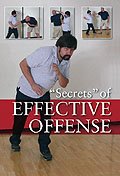 No Nonsense Self-Defense - Reliable information for dangerous situations. The site of Marc "Animal" MacYoung, someone whom I've read of repeatedly, and Dianna Gordon. I'll be going through the site and writing on it over the next couple of weeks. Check it out.
No Nonsense Self-Defense - Reliable information for dangerous situations. The site of Marc "Animal" MacYoung, someone whom I've read of repeatedly, and Dianna Gordon. I'll be going through the site and writing on it over the next couple of weeks. Check it out.
Gumby with BJJ Types Pt 4
Just a few (go to this link to read it all):
The Future Champ:
He is pure Bigger wanna-be carioca, knows the names of every BJJ champ and the latest gossip from the UG. He talks about being Mundial champion from whitebelt, yearns to move to Brazil to train, is always looking to do another seminar or private with a Brazilian, and yet does not attend class regularly, always has an injury or excuse when it’s time to compete, wants to drill rather than spar, and talk rather than drill.The De-Man-Izer:
This is the small person (often a girl) who will single out the biggest, highest ranking male she can find, then fling her tiny body at him and proceed to beat him down and tap him within an inch of his life. Often, her victims will lose all testicular fortitude, cry, and quit the sport for life…The Tough-Ole-Bastid:
This is the guy who started later in life but despite his age, he is tougher than 90% of the twenty-something’s. He can get kneed in the head, kicked in the groin, or have his arm near torn off, and barely grimace as he continues to grapple (often against someone a lot bigger).
Eddie Goldman's Diary Entry

If, like me, you're a boxing fan in exile, and have pined for the days of unified championships (as opposed to dozens of "world champions" in each weight class), then you'll appreciate this Eddie Goldman piece on The Sweet Science.
Thursday, May 25, 2006
Has MMA/NHB passed the Gracies?

In this old (1999) article, Brian Kodi challenges some of the early dominance of Brazilian Jiu-Jitsu in his article, "Weaknesses of Brazilian Jiu-Jitsu." I'm sure there are as many political (mostly) arguments in the grappling/NHB game now as there were in the 80s and 90s in Jeet Kune Do, but he raises some points. If you have an opinion or counter-argument and can articulate it, please comment or email. Keep in mind, my inexperience on the subject. My interest is primarily in what works to save your life, not win a tournament. This article is timely in that some of his points are about the obsolescence of BJJ in light of the more current developments to combat it (better striking from within the guard, better takedown defenses, etc.).
Some of his points:
- Royce made his mark and promptly took a leave of absence following his 35 minute draw against Ken Shamrock in UFC 5. He has been missing in action for quite some time. Reason: Proficiency in BJJ is no longer the dominating factor in NHB success, and Royce can no longer be the formidable fighter he once was under no time limits.
- Training predominantly with a gi in BJJ has become a detriment: Brazilian Jiu Jitsu is excessively dependent on clothing to hold, reverse and submit. Since most contestants in NHB do not wear a gi, Jiu Jitsu loses a part of its potency.
- The BJJ guard has lost its effectiveness in NHB...
- Takedowns are not adequately addressed in BJJ: The prevailing philosophy
has been that going to the ground is the goal, and how you get there is of less importance.- Minuscule lower body submission: Experienced Shootfighters can end the
fight against the BJJ elite at a moment's notice. Allan Goes' ankle was badly
broken by Frank Shamrock in a Pancrase match. Goes was lucky the referee gave him an escape since he was too close to the edge of the ring. After the cast was taken off his ankle, Goes became determined to master the lower body submission game. During one of his trips to Brazil, he surprised many of his previous grappling partners by applying quick lower body submission techniques. The persisting hostile stance of the BJJ community to lower body submission only adds to this weakness.
Read it. He backs up each of his opinions with reasons, and that's the only opinion I respect or post on. He ends the article with a good point (I was looking for it), "On a final note, it is important to distinguish between a training regimen for NHB and a street fight. In a street fight, your opponent is fully clothed and does not expect to be triangle choked. Training exclusively with clothing, a handicap in NHB, becomes a potent weapon in a real fight."
I look forward to hearing back from some more seasoned practitioners of grappling/BJJ/NHB with thoughts.
UFC - Shocking Results!
One thing I thought was interesting was that Bill Wallace and Kathy Long were doing the color commentary and ringside with NFL great Jim Brown. It was odd, but it worked. I think that, at the time, Long was an active champion in full-contact, with training in San Shou or something, and Wallace had retired a few years before with an exemplary record, plus freestyle wrestling and Judo experience. Wallace could've provided the most expertise in commentary, followed by Long, but I'm not sure what Jim Brown was doing there. He may have had some free time that day, and really seemed to enjoy it!
Briefly (for those as out-of-the-loop as I), UFC 1 featured the following matchups:
Bout 1 - Gerard Gordeau (Savate) vs. 400+ pound Teila Tuli (Sumo) - This was actually pretty interesting. It featured someone who looked the least imposing (Gordeau), versus one who you'd think would be a powerhouse. Keep in mind that this style versus style-type matchup hadn't been done before. No one really knew for sure what would happen with a sumo versus a striker. Result: It was over quick (26 seconds), with Tuli shooting in for what looked like a single or double-leg takedown. Gordeau backpedaled fast, then sidestepped, and Tuli went down against the octagon fence, then Gerard threw a really nice looking round kick to the face of Tuli. It looked like Tuli's face was smashed - some teeth came out, and he looked like the orbit of his eye was broken, and he had a smashed up nose. Blood everywhere, and they stopped it, though Tuli looked like he could have continued. I think there was a lot of confusion in the rules on whether a fight should be stopped on cuts. Anyway, it was over quick, and Gordeau showed some impressive ring savvy. I was surprised, because he looked like a pushover, based on his physique.
Bout 2 - Kevin Rosier was touted as a champion kickboxer, though I'm not sure how much that was fudged (I will research and correct this post) versus American Kempo stylist Zane Frazier was pretty good. What you had was a very large, and out of shape Rosier fighting a taller, but lighter and more mobile Frazier, who was also in horrible shape for this. Both are strikers and were clearly out of their element on the ground, but, even though Rosier was pursuing Frazier around the ring, Frazier was decisively winning. In the clinch, he'd knee and uppercut very effectively, and Rozier was absorbing a lot of punishment. I was amazed that, after winning the fight up to that point, Frazier just ran out of gas and collapsed and his corner threw in the towel. Was a pretty good streetfight, but not impressive by today's standards. Incidentally, according to the Sherdog stats, Frazier has 14 MMA bouts to his credit, (4-10-0), and fought as recently as November.
Bout 3 - Royce Gracie (BJJ) faced Art Jimmerson, a light-heavyweight boxer. I think he was ranked in the top ten of one of the alphabet boxing organizations, and this one went as you’d expect. Royce did his signature stamping kick to keep the boxer away, and Jimmerson, never landed anything that I remember. What was interesting was that Gracie had his gi and unwrapped hands, while Jimmerson had a boxing glove on his left and nothing on his right, as if he were going to grapple. He’d probably have been better off with gloves on both hands, as shortly after the first round began, and a short feeling-out process of circling, Royce shot in, took Jimmerson down, then began to apply pressure from the top. I can’t remember whether he even started to get anything from the top, but Jimmerson tapped real quickly. He had no chance. I wonder how he’d have done by moving laterally and jabbing. Probably the same, but with a minute or so longer to his credit.
Bout 4 – Ken Shamrock (shootfighting) faced Patrick Smith, a big TKD stylist with an announced record of 250-0! I’m surprised Bill Wallace could actually say that without laughing. Anyway, without almost any standup or TKD kicking occurring, there was quickly some clinching and standup grappling occurring. To his credit, Smith actually held his own for much of this bout, but the results were almost inevitable – Shamrock took him down and won shortly with one of his favorite techniques from those early days, a heel hook. Smith was game though, and wasn’t a pushover. Smith actually came back in UFC 2, winning three bouts in a row (2 by submissions!), before being submitted by Royce. He’s compiled a 9-11-0 record, according to Sherdog.com, last fighting in 2003.
Bout 5 – Gerard Gordeau quickly TKO’d Kevin Rosier in less than a minute. If Rosier was actually a kickboxer, he didn’t show it. He was beaten down and stomped before his corner threw the towel. Gordeau used leg kicks to great effect, though they didn’t look like Savate, as far as I could tell, but Muay Thai. This was a good matchup for Gordeau because Rosier couldn’t grapple, and was too out of shape and bloodied from his previous match to put up much resistance.
Bout 6 – Royce Gracie submitted Ken Shamrock with a nice rear naked choke. Ken was actually pretty gracious in defeat, and gave credit to Gracie for the move, though he cited his inexperience versus BJJ as the reason, and that he was concentrating on going for the legs too much as the reason. It was interesting that Gracie had such a killer instinct, as after he tapped, Royce let go, but the ref didn’t see the tap, so Gracie jumped back on and started choking again, then Shamrock tapped again, and the ref called it.
Bout 7 – In the final, Royce faced Gordeau, and it went as expected. Royce took him down and submitted with the rear naked choke in just over a minute. I respected Gordeau a lot after seeing how he handled this tournament.
Analysis:
First of all, none of the fighters was well known, at least to me, at the time. In addition no one was really prepared for this type of competition, except Gracie. The competition was seriously lacking in training for the ground (except Gracie and Shamrock), and they actually didn’t look competent in stand-up, with the exception of Gordeau. I ask now, the same thing I asked back then, “Who are these guys?” In other words, where were the “big name” fighters, or those willing to represent their systems?
Technique-wise, there wasn’t much, except for Gracie, Shamrock, and Gordeau (for that matter, where was the Savate?). I understand that was the story for the next couple of UFCs, then it started getting better in a hurry. What I was looking for, however, was a TKD stylist using TKD, Kenpo fighters using their system, etc.
Why did Gracie do so well? I can’t say that it was because of the competition, because he fought the best fighters on the card, and came out on top. I still think that it’s because their (the Gracie) system is superior on the ground, and the surface (the octagon) was conducive to takedowns and being on the bottom. You also notice that Gracie was the only one to use the open hand striking well, whereas Rosier’s (and all the pure strikers) hands were bloodied within a few seconds. The only reason the boxer’s hand weren’t broken was that Royce never gave him anything to hit, then he was on the ground and his punches were ineffectual from the bottom.
Watching this really showed me how far the sport has come, and why there is a widespread belief that MMA will surpass boxing as a sport (if it hasn’t already). FYI, Sherdog has a bout 7 in its listing that makes no sense, and doesn't apear on the DVD, a Jason Delucia versus Trent Jenkins. No idea where that came from!
I’d recommend a look if you haven’t seen it!
Wednesday, May 24, 2006
New Link - Crime: Information and Prevention
Learning the Hard Way
LEARNING THE HARD WAY! Eight-thirty p.m. 16th December 2001. The night that changed the way I think about self-defence. I left my office after a very long day. I was tired, cold and hungry and all I wanted to do was get home and relax. Talk about being in Code White! That was definitely me that evening.
At the rear of my office there is a large enclosed yard that we use as a car park, it’s dark and very secluded. I had done all the usual security checks in the office; set the alarms, locked all the doors and windows etc. I now found myself walking across a pitch-black car park towards my vehicle, head down[!], pissed off, switched off and just wanting to be at home. As I approached my car I gave the yard a cursory[!] scan then opened the door and climbed in[!], placed my briefcase behind the seat and put the key in the ignition. As I lent across to grab the door handle…BANG!! There he was, or should I say there IT was, a Stanley Knife pressed into my throat, accompanied by a blood-chillingly calm and almost softly spoken statement, which I believed, and which will stay with me for the rest of my life, “Struggle and I’ll cut your fucking eyes out”. It was actually the verbal attack that made me feel more vulnerable than the knife at my neck. In fact, for a split second I felt as vulnerable as a five-year-old kid. He was a big guy, a good six-footer with a heavy build, probably in his thirties, with a broad Scottish accent. He looked the part too, heavy padded fleece coat, black balaclava, gloves, the full bad guy uniform and all in all a real evil bastard who would, without doubt, resort to extreme violence to get his way. This man intended to rob me, cut me, maybe even kill me, and not necessarily in that order. The cool, calm, verbal aggression, the body language, his general demeanour told me so. I was scared. He was in control.So here I was, in the shit big-time, and guess what was happening while I was thinking “I’m a martial arts expert, this can’t be happening to me?” That’s right! It was happening to me. Over forty years experience in ancient and modern combat systems, more black belts than you can shake a stick at, author of one the world’s best selling books on self-defence, trained with some of the world’s most eminent authorities and masters, inventor of the famous R.E.A.C.T. system of personal protection. The list goes on and on. And for what? To suffer, or even die, at the hands of this piece of crap? Was this the way it was all going to end? No fucking way! Don’t get me wrong, this was not cool James Bond grit in the face of danger. I was feeling the full effects of real fear; cold sweats, I could hear my own heart beating, I was frightened and I’m not ashamed to admit it. However, I followed my own advice, stuff I’ve been teaching for years;
FEAR IS YOUR FRIEND, STAY CALM, DON’T STOP THINKING, CHOOSE YOUR MOMENT AND TAKE CONTROL!
“Get into the passenger seat,” he said. I was compliant and slid across to the other side of the vehicle. I sat sideways on with my back against the passenger door, believing this to be a stronger position to fight from. The knife was still in my face as he moved into the vehicle beside me. “Get your wallet out,” was the next order. Once again, I did as I was told. I knew that I only had about £25 ($18) in cash, not worth getting your throat cut for. I handed over the money, which he stuffed into his pocket. Next he demanded my credit cards and their pin numbers. I told him I didn’t know the numbers, which was actually true, to which he replied, “ Bullshit, that’s what they all say, you’ll fucking remember them by the time I’ve finished with you!” I now knew that this man was a professional, and I believed myself to be in grave danger, but this knowledge actually had the effect of strengthening my resolve. Tony Blauer’s cerebral self-defence filled my mind. “Get out of the fear box, Steve, and get out of it now!” I said to myself. I closed my wallet and calmly placed it in the well between the seats, next to the parking brake. I had gone as far as I was going to go.
Now I don’t consider myself a brave man, but knife or no knife, I had made my decision. This man was going down...
Tuesday, May 23, 2006
Welcome MMABlogger readers
Sunday, May 21, 2006
Which Way Do You Slip the Lead?
The reason to slip is that it:
- Keeps you in range to counter
- The miss by the lead-off fighter will cause him to be momentarily off-balance. Conversely, if he leads and you block, you are still in his targeted area, and you haven't thrown off his balance. To test this statement, hold a shield or target for someone, then, without warning, move it and see what happens.
A slip to the inside is defined as moving your head and body to the side of the attacking arm with the inside of his elbow. For example, slipping to the inside of an orthodox fighter is to slip to your left. A slip to the outside is to go to the side of the arm where his elbow bends, or to the right of an orthodox fighter. Let's look at some examples, and why they may or may not be a good idea.
Slipping the lead to the Inside:
1. I lead off. Sam taks a step to his left
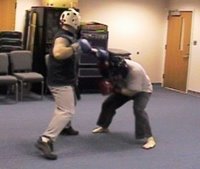
2. ... which is a mistake, because my power hand is my right, and I just have to complete my 1-2 combination
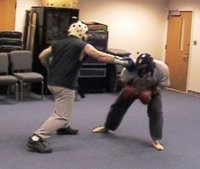
3. The combination is complete
Slipping the lead to the Outside:
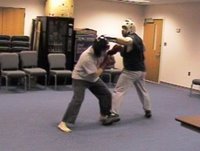
1. Sam sees the lead coming and moves his head and body to his right, just outside of the punch

2. Even though I double up to try to catch him, he does a step-around move
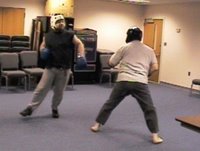
3. Then he clears safely outside of punching range
ANALYSIS:
How would you make a slip to the inside work?
- Bob & weave to the left, so that your right shoulder is forward, and throw a counter at the same time
- Bob & weave to the left, so that your right shoulder is forward, and right hook to the body, or overhand over the extended lead arm
- Slip inside, close, and takedown/tackle
- Slip inside, close, and clinch
A more effective slip to the outside?
- Simultaneously jab with your lead hand to the head or body
- Use a check with your rear guard hand and step around so that your have flanked your opponent
Saturday, May 20, 2006
Coach Shamrock vs. Coach Tito No Contest So Far
 MMABlogger has a blunt opinion on Ken Shamrock’s coaching prowess, with which I happen to agree. On the "The Ultimate Fighter" (at least so far), Tito has shown a coaching style that seems more effective, to say the least. My expectations were also high, considering Shamrock's past glory as a fighter, but even more so as a coach.
MMABlogger has a blunt opinion on Ken Shamrock’s coaching prowess, with which I happen to agree. On the "The Ultimate Fighter" (at least so far), Tito has shown a coaching style that seems more effective, to say the least. My expectations were also high, considering Shamrock's past glory as a fighter, but even more so as a coach.At the beginning of UFC’s “The Ultimate Fighter” 3, I thought that Ken Shamrock would be far superior to Tito Ortiz when it came to coaching. After all, he has his legendary “Lion’s Den” team that turned out a lot of good fighters, like Frank Shamrock, Guy Mezger (where is he these days anyways?), Vernon White, and some other guys I can’t remember right now.His choice of assistant coaches is questionable.

The boxing coach makes sense…but still.And his blunt assessment:
Personally, I was hoping he’d bring out some of the old Lion’s Den fighters to help him coach (imagine Ken and Frank Shamrock coaching together??? I’d pay to see that on PPV).
So far in TUF 3, he’s the worst coach ever!I think he's right on. If you watch the show, you'll probably agree.
Is it the Style or the Individual?
Put in its clearest form, the issue is this: "Which is more important to the overall combat effectiveness of a fighter: the attributes and qualities he or she possesses as an individual, or the style of fighting that he or she practices?"Read the rest for his answers.
If we claim that style is more important, the obvious implication is that some styles of fighting are more effective than others. Such a statement will obviously not sit well with those whose fighting style is counted among the less effective - nobody enjoys being told that their preferred style, in which they have invested so much time and effort, is less effective than the competition.
The more diplomatic answer appears to be the claim that combat effectiveness is entirely up to the individual. The obvious implication of this statement is that fighting style does not count. If the individual simply trains hard in whatever style they happen to practice, then they shall prevail. This makes it appear that all fighting styles are equally good - a stance that will not offend anybody.
In this short essay I shall argue that in fact the style of combat you choose is crucial to determining your combat effectiveness that some fighting styles are clearly superior to others ...
Knives Don't Kill People;People Kill People
 In the UK, because of it's ubiquitousness in attacks, there are "Call for tougher knife laws ." Doesn't it make sense that now that guns have been outlawed, that criminals and the law-abiding alike would arm themselves with something else? Now that there has been a large increase in stabbings, there are calls to toughen penalties. What's next-clubs?
In the UK, because of it's ubiquitousness in attacks, there are "Call for tougher knife laws ." Doesn't it make sense that now that guns have been outlawed, that criminals and the law-abiding alike would arm themselves with something else? Now that there has been a large increase in stabbings, there are calls to toughen penalties. What's next-clubs?
Friday, May 19, 2006
New Link - Gumby's OntheMat Blog!

Gumby's OntheMat Blog says that it's about "BJJ, Grappling, MMA, and whatever else is interesting." I agree. I saw a link to it on MMABlogger, and had to check it out. His posts on the BJJ Types are hilarious. Let me know what you think!
Gangs and Revenge
 A scary look at the world of gang violence and revenge by Loren Christensen. In "IT’S ALL ABOUT REVENGE," Christensen discusses the various ethnic gangs and how they operate.
A scary look at the world of gang violence and revenge by Loren Christensen. In "IT’S ALL ABOUT REVENGE," Christensen discusses the various ethnic gangs and how they operate.From the article:
In the gang world, no challenge, assault or diss (act of disrespect) can go unanswered since being a gang member is all about holding onto respect and reputation (rep). When a diss occurs to a gang by a rival, only revenge will satisfy the offended gang. To them, revenge shows the world (mostly themselves, really), that their rep is intact and is to be respected. Gang history teaches us that revenge will be in the form of a bloody beating, a bullet-spray drive-by or even a bombing.
When the offense is to an individual gang member, there is an expectation within his gang that the offended member will automatically seek revenge to uphold the rep that has been given to him by his peers. In fact, the expectation is so great that if for whatever reason a member doesn't strike back, he may have to face the rage of his own gang. "A banger's gang will give him hell if he doesn't get revenge when he's been dissed," says Detective Doug Justus, a veteran gang officer on the West Coast. "Often times they beat up their own member for not doing a payback." Offend a member, and the gang's reputation is also at stake.
Read it.
Updated Best of TDATraining
Thursday, May 18, 2006
The MMABlogger on Why We Get Hit
The only thing I can think of that’s missing is getting hit while you’re expecting something else (GHWYESE)[Touche!-NDT]. For example, someone keeps on throwing leg kicks at you while looking at your legs, and next thing you know, he’s looking at your leg, he fakes a leg kick, but since you’re expecting a leg kick you defend with a leg block…but all of a sudden he’s throwing punches at your face.
... which is true. My emphasis in stand-up recently has been on checking and bumping to create openings and clear, but also feinting and faking to create openings, as MMABlogger is iterating. Of course, this is covered in reasons stated in the original article (out of base defensive stance, back on your heels, and/or improper guard), but he's talking about how to get your opponent to create the opening by biting on a misdirection or fake. It's a good point.
BTW, check out the videos and opinions on MMABlogger-they're usually excellent.
Multiple Attacker Nightmare

Ever faced multiple attackers? I've cover what I 'd do as an attacker in a previous post, but how do you handle it? I've received some training in it over the last thirty years (yes, I'm old!), but never had to do it, thank God.
Check out this useful Defend University article by Brad Parker on "Styles, Attributes and Strategies for Successful Self-Defense" versus multiple attackers, called "Facing Multiple Attackers?" It's an excellent compilation of recommendations from some very qualified individuals and Parker himself on what actually happens in multiple assailant attacks, what styles lend themselved to proficieny in defending it, and what skills and attributes you should have to be successful. Excerpts:
This jibes with other articles I've read:
Studies show that assaults are more likely to escalate into homicides when there are multiple attackers, particularly when the attackers are juveniles.Specific tips (from Loren Christensen):
...it is possible for a single person to defeat multiple attackers. I have seen a video of Royler Gracie avoiding and evading two of the largest L.A. County Sheriff’s Deputies present in a seminar. These two brutes could not control Gracie and it was obvious that they would not have been able to keep him in one place long enough to assault him. Similarly, I have a video tape of a single suspect virtually destroying two Texas State Troopers. To make matters worse, the two officers are both hitting the suspect with expandable batons and the suspect ends up flooring both officers with punches.
Evidently, in these situations, the two combatants were not equal in the skill or strength of the single combatant.
So how do you train to become so skillful that you can reasonably expect to defeat multiple opponents? Is there a style that most advantageous to study? What are the best strategies and techniques?
1. You must think quickly and anticipate the attackers’ moves.From Geoff Thompson:
2. Think in terms of striking targets that either stun or are potentially lethal. Consider striking the temple, throat, mastoid, spine, solar plexus, kidneys, groin, and knees. These targets maximize the effectiveness of your blows, thus conserving your strength and energy.
3. You must control your breathing to keep your anxiety in check and your energy level high.
4. Move fluidly with grace and balance.
5. Power can be increased by adding leverage, speed of delivery, and mass.
6. If you are fighting with your hands, be careful not to injure them.
Much, much more. Worth reading!“I have probably been involved in more than 100 fights where the numbers were against me,” he says. “I won because I was first to initiate the physical attack.”Thompson also fears getting flanked by opponents. “Part of the attacker’s ritual is the pincer movement. One attacker, usually the one facing and threatening you, will deploy your attention while the others attack from your blind side.”
Thompson’s training is traditional karate, boxing and judo. He usually advocates knock out blows.
“If you feel an attack is imminent, attack first. This is the most critical factor in such a scenario,” he says.
“My own preemptive strike would be a right cross/hook to the jaw preceded by some kind of mentally disarming verbal communication, hopefully neutralizing the first person,” says Thompson. “Then I would attack with headbutts, punches, or kicks to the remaining antagonists, depending upon my distance from them.”
P.S. If you have had to fight more than one opponent simultaneously, please email or post a comment on what happened, and your thought on the original article. Thanks!
Wednesday, May 17, 2006
Preventing Sexual Abuse in Martial Arts
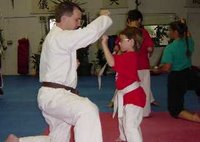 I originally posted this on April 22, but I am reposting it because another instructor has besmirched the integrity of our "profession." Again, I strongly urge parents, school owners, and instructors to work together to enact strict measures to protect our vulnerable students.
I originally posted this on April 22, but I am reposting it because another instructor has besmirched the integrity of our "profession." Again, I strongly urge parents, school owners, and instructors to work together to enact strict measures to protect our vulnerable students.+++++
This is not good! I have long thought that there needs to be more "self-policing" by the martial art school owners in this respect. I have been a Scout leader for several years, and martial arts instructor for many, many more, and I can tell you that there needs to be common sense on the part of school owners, instructors, and parents to protect our kids. How? Please consult with your state laws, but, like the policies the Boy Scouts have implemented, most are common sense.
For school owners and instructors:
- DON'T ever be alone with a child without another adult or group of students present or visible. For example, if you have to discipline a student (assume child), move to an area that's not in front of the class, but off to the side, or in a clearly visible area. In my schools, we had offices with doors, but they had windows to class areas or to the outside so that there was visibility. It was also to watch for foot traffic outside and observe classes, but also so that there wouldn't be a doubt as to what may have occurred in an office.
- Do not touch a child (or any student or co-worker) in a way that may be construed as sexual, improper, or coercive. Train your instructors and assistants in the same.
- DO require criminal background checks for all instructors, including volunteers. It may be free from your local police department, and will go a long way toward reassuring prospective students and parents that you are conscious of this.
- DO keep an eye on what's going on in your mixed (adult-child) classes, and don't allow adult male students to be in locker rooms or other changing areas alone with underage students.
- For trips to tournaments or seminars, DO require a number of parent chaperones that makes sense logistically. DON'T take the kids yourself without a parent or other instructor there. While away, do not let students wander on their own - buddy system and regular check-in are recommended. Let the age of the students determine that.
For parents:
- As above, make sure a school has the criminal background checks in place (ask to see a written policy that you can have a copy of), as well as the policies about being alone with students and that all training areas are visible to the public. Background checks should include fingerprinting of prospective instuctors.
- If you have a "strange/funny feeling" about something, go with your instincts. It's YOUR responsibility to protect your child. Don't entrust that to anyone, no matter how much you respect them, unless systems and policies are in place to ensure compliance.
- Be involved, and talk with your child so that you will know if something doesn't seem right.
- If something does happen, do everything you can to put away the molester so that it doesn't happen again to other kids. We need to stick together to protect our kids from the monsters that prey on them.
Those are my thoughts on it. As I said, common sense...
Defending the Shove
Read the rest for the answers.Q:
I was wondering: would you say that fights often escalate from shoves where one person shoves another to try to intimidate that person?
If you were shoved by someone, what would you recommend to counter a shove in a way that lets the 'shover' know if he were foolish enough to continue trying to
intimidate you (further shoves, trash talk, etc.) , that you can more than
handle him, thereby preventing a fight in the process?
A.
I used to have a statistic from the Department of Justice that showed something like 74% of all assaults begin with a push or a shove. So, yes! -- a shove usually indicates the initial stages of an assault.
One common type of opening gambit is to shove the intended victim back to give the attacker range to connect with an overhand right punch. The key here is that the attacker is using the shove to "control" the distance. It's the same when the attacker grabs your shirt with one hand and curls it in. He is either pushing you away or grabbing you to control the distance to maximize the effectiveness of his punch.
On the shove, I've noticed that many guys (who are shoved) try to stop their rearward motion and react by stepping forward again to show the attacker that they aren't scared -- BOOM! They step right into the punch that is following the shove.
2nd Fairfax Officer Dies from Ambush Shooting

Master Police Officer Michael Garbarino of the Fairfax County Police Department died today from multiple gunshot wounds he received on May 8, 2006 during an ambush behind the Sully District Station in Chantilly, Virginia.
Please join us in extending your thoughts and prayers to the families and co-workers of both courageous officers.
See previous post.
Tuesday, May 16, 2006
Knives remain the biggest threat to police safety

This article, although written based on UK statistics, backs up what I have read repeatedly, that knives are one of the biggest threats for police. The reasons seem to be that blades are readily available, inexpensive, easily concealable, and very effective. The article states that, "... research reveals 7,000 officers have been threatened with a gun and 40,000 a knife, in the last two years."
This points to the need for continual drilling of DT based on the probability of the threat posed by bladed weapons. Read the rest.
Fight or Flight

An old article Brian Kodi expounds on Fight or Flight at BJJ.org:
The ideal state in a confrontation is one of moderate anger and/or fear. Excess of either of these two mental states can stifle reaction and hinder performance. Deficiency can lead to foolish mistakes. To achieve a moderate mental and physical state in an altercation, the two most important elements are confidence and experience, neither of which are sufficient to complete the desired effect alone. A confident beginner in any style of martial arts is a dead man in the making. An experienced fighter who suffers from a lack of confidence is bound to meet the same fate.
Confidence is best developed through successful trials of actual combat (experience). Since combat involves an unacceptable risk of injury among other negative connotations, full contact sparring with heavy protective gear in a practical style(s) of martial arts is a good substitute. Uncertainty is a major contributor to losing control from excessive fear. Hence it is essential to experience firsthand what it feels like to take blows to the body as well as being controlled on the ground.
Read it all.
Monday, May 15, 2006
Jon Bluming, Europe’s first Mixed Martial Artist
 Fascinating interview of John Bluming in RealFighting.com. The introduction:
Fascinating interview of John Bluming in RealFighting.com. The introduction:"Jon Bluming is a leader of Europe’s International Budo Kai Kan Foundation. Born in Holland 1933, he is a veteran of two tours in the infantry in Korea. After receiving 3-dan in judo in Holland, he went to Japan in 1959, where he lived until 1961. His instructors included Donn Draeger, Mas Oyama, Kenji Kurosaki, and Ichitaro Kuroda, and he is graded in judo (9th Dan), karate (10th Dan), iaido, and jodo."
On the quality of the martial arts in the US
... in the USA. I have seen karateka with terrific names in the USA and so called champs who could hardly beat my grandmother if she had an umbrella in her hands.
On picking an instructor/school
One should always go into the background of the sensei he wants to study under, and then decide if it’s worth it. Now don’t forget there are very good sensei’s who never really fought in a contest but have the ability to show their students how it is done and make good teachers and champs in the process.
On the many 10th Dans in the US
There are more clowns with red and red and white belts in the USA than at the Barnum and Bailey circus. It amazes me how many 10th dans there are running around, whose only concern is to make money and promote themselves, they never amounted to anything but B*** S***.
On the seven throws he teaches his students
Well to show them the way, how everything started from the beginning I show them the 1) Uki-goshi, the ordinary wrestling hip throw, and the second one is the full hip-throw2) O-Goshi (the hip is completely in) the third one is the hip-leg throw 3) Haraigoshi), the next one is 4) Osotogari (going to the back), then comes 5) Ippon seionage (going under a puncher’s arm and throwing him over your head), 6) and the next one is kosoto-gake, on the other side, backwards, then the last one is Deashi-kake, like the kickboxers do, but right behind the ankle with the inside of your foot.
Those are the seven throws I show them, but I always tell them, look, you don’t really need to know those seven throws really well, but if you only have a good hip throw - a good Haraigoshi, and a good Osoto-Gari, and a good side kick like a good kosoto-gake, or Deashi-Kake, then you’re in, that’s all you need.
On his opinion of the Gracies
You know, I admire Gracie, at least the first one, some of the other ones, I don’t know, they are big mouths. I saw one last February fighting at Rings, and he was just a big showoff, and he caught a low kick so hard that both legs came from the floor and he banged his head. Every time they try to rush forward and grab your legs, but
you know what’s funny about it, they know as soon as they grab your leg, there’s always one leg on the tatami. Once that happens, you are not allowed to hit him.
If I would fight a guy like that, I would tell him, look, even at my age, I like to fight you, but no rules! So more bullshit with one leg on the ground, and I’m not allowed to hit you, so once he comes in then, I will punch so hard, or a shuto so hard, it will break his f****** neck. But you’re not allowed to do that.
There's a lot more. Read it!
Officer attacked (attempted) by three suspects...

The second male on the ground was now crying because of the pain from the pressure on his wrist while the third male was still trying to pull himself free and eventually pulled the first male away from the assisting male. While still maintaining control of the second male's wrist, I stepped on the base of the first males skull to keep him down on the ground while the civilian grabbed his free right arm. Within seconds, back up units arrived and assisted in handcuffing the second male, I used my only pair securing the first and third together. It took three other officers to control the other two who had to be uncuffed and then cuffed separately as they continued to resist.
Foiled rape attempt
Sunday, May 14, 2006
Knife, camera phone foil rape
The Telegraph - Calcutta: "British tourist Isabella Scott, 28, whipped out a pocket-knife from her bag and fought off a rape attempt on Puri beach, then captured the attacker on her phone camera before he got away."
Successful "Failure" of a Pre-Attack Interview
"Failing your next interview can be a good self-defense strategy in preventing a rape and possibly save your life.
Because they are more "predatory" in nature than "opportunistic" (although there are certainly rapes that occur during the commission of another crime simply because the opportunity presents itself -- like say, during a burglary -- the majority of attacks are planned) rapists are on the lookout for their next victim.
Part of that game is to identify potential victims. One element of that process is to simply observe or case situations where women might be available and alone. Remember that the vast majorities of rapes are committed by someone who is acquainted with you and your situation. I'm not saying they are friends with you, just that they've seen you, they know where you work, live or shop.
Another element in their game is to "interview" you to see if you are going to make a good victim..."
Read it all.
Saturday, May 13, 2006
Give Thanks for the Thin Blue Line

Today, we pay tribute to the sacrifice of all law enforcement officers and their families for the sacrifice and risks that they assume daily in defense of our lives and property. Too often, they pay the ultimate price, and a family is torn apart and a community mourns, and reflects.
I will not be blogging further today out of respect for the funeral services honoring the life and death of Fairfax County, VA detective Vicky Armel, a wife, a mother, and veteran police officer in the county adjoining mine. Det. Armel will be honored today by thousands of officers and citizens around this area, and around the country who will remember. Please join me, and pray for her family. Thank you.
++++++++++
Updated 5/17/06, Master Police Officer Michael Garbarino of the Fairfax County Police Department today, May 17, from multiple gunshot wounds he received on May 8, 2006 during an ambush behind the Sully District Station in Chantilly, Virginia.
Friday, May 12, 2006
The Quick Pistol Disarm
 FightingArts.com - The Quick Pistol Disarm: An Aiki-Jujitsu method, By Prof. Gene Roos
FightingArts.com - The Quick Pistol Disarm: An Aiki-Jujitsu method, By Prof. Gene Roos"The advantage of this method is that even a small and weak person can use it against a much larger stronger attacker."
Read it
FLOYD PATTERSON, 1935-2006
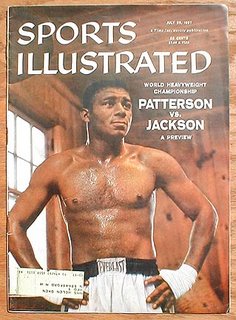 From NO HOLDS BARRED: FLOYD PATTERSON, 1935-2006:
From NO HOLDS BARRED: FLOYD PATTERSON, 1935-2006:"Floyd Patterson, the former two-time heavyweight champion of the world, and one of the most beloved and popular figures in the world of boxing, died Thursday at the age of 71."I've always loved boxing, growing up at a time when you could actually watch the championship fights on TV(!), and everyone knew who the heavyweight champion was, if not several other weight classes. Though the fight between Ali and Patterson occurred before my time, I loved reading the stories of his trainer Cus D'Amato bringing him up from obscurity, and watched with great interest as that figure from the past (D'Amato) brought the young Mike Tyson up in the same way.
His conflicts with Ali aside, I don't remember anyone ever disparaging Floyd Patterson, and wish I could have met him. Condolences to his family and friends.- NDT
Thursday, May 11, 2006
On-Screen Heroines Inspire Women to the Martial Arts
 From the Village Voice by Jill Morley
From the Village Voice by Jill Morley"Michelle Yeoh and Zhang Ziyi became role models for women in 2001. And on the heels of Crouching Tiger, Hidden Dragon's four Academy Awards-including the statue for Best Foreign Film-Yeoh and Zhang's status as heroines has only been further entrenched. They made Kung Fu look beautiful, athletic, and sexy-much as Cameron Diaz, Drew Barrymore, and Lucy Liu did in Charlie's Angels and Sandra Bullock did in Miss Congeniality. These are qualities that are held high and yearned for in our culture. So it should be no surprise that there's been a recent surge in women taking up the martial arts. "
Read the rest
Why Do We Get Hit?
- You are out of your base defensive position (OOP)
- You are back on your heels (BOH)
- Improper guard for the range (IG)
Out of position (OOPs)
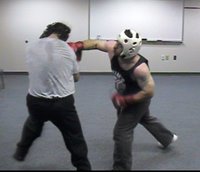 In this case, Sam is out of his defensive position. From an offensive perspective, this means he is flanked, thus his guard is ineffective
In this case, Sam is out of his defensive position. From an offensive perspective, this means he is flanked, thus his guard is ineffective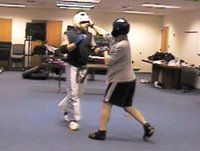 I may have been backpedaling or something, but Sam took advantage of it. My guard was down and my feet were almost crossed. Not a good position.
I may have been backpedaling or something, but Sam took advantage of it. My guard was down and my feet were almost crossed. Not a good position.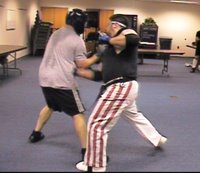 Nothing new to add except that this body punch will "freeze" my opponent for more damage.
Nothing new to add except that this body punch will "freeze" my opponent for more damage.Wednesday, May 10, 2006
What the purpose of tests?
Josh Barnett: Pro Wrestling Moves work in MMA
 Josh Barnett interview:
Josh Barnett interview:"If I may say so, there's not that big of a difference between pro-wrestling and mixed martial arts. There's not that big of a difference between the techniques of pro-wrestling and mixed martial arts. There's risk that comes along with mixed martial arts techniques. Looking at Carl Gotch and Bill Robinson's matches, I don't feel there's a big difference between mixed martial arts. The basic parts are connected but not everyone can use Double-Arm Suplexes or German Suplexes. You can use them if you learn the skills that I have.
I use pro-wrestling moves because I want to entertain the fans and I want to prove that pro-wrestling is the best. It's boring to fight the same way all the time, just because the rules are the same, right? I want to show the fans things that only I can do, and as a professional fighter, I understand that I'm expected to give an exciting fight that will entertain the fans. That's the kind of fight that I want to show them."
Tuesday, May 09, 2006
The Knife-Wielding Man Was Lucky
By JENNIFER STEWART Staff Reporter
A Dartmouth man, whom police were forced to subdue with a stun gun Friday night, will be in Dartmouth provincial court today.
The man, who has not been identified, was arrested at a residence in the 100 block of Albro Lake Road after allegedly assaulting his girlfriend and coming at police officers with a knife.
Police were sent to the house at about 11 p.m. A woman there called to say she'd been attacked by her boyfriend, who was still in the house and armed with a knife.
When the officers arrived, they had to break in the front door to get inside. The man then ran to the bathroom and locked himself inside.
Police broke in that door and confronted the man, who had the knife held against his throat.
When the two officers, one armed with a handgun, the other a stun gun, moved toward him, he came at them with the knife, police said.
Police said the officer with the stun gun delivered a quick shock that subdued the man. He was arrested and checked out, but police said he did not suffer any injuries."
Great stunt and trick video footage
http://www.extremely-sharp.com/direct/communitycenter_video_martial_arts_stunt_boon_hau.html
One of these guys did some of the Sith stunts in the last three Star Wars movies, now they are expanding with ESKnives.com. Footage includes a couple of tricks, some weapons displays, as well as raw footage of his performance in Star Wars fight scenes with Team Ryouko at the Toronto International Circus Festival 2005.
+++++++++++
Franklin's right, it is very cool. About a three or four minute video featuring some great moves. since my competitive heyday (about 15 years ago), I've been amazed at some of the things that kids can do now. With the synthesis of martial arts and gymnastics that took place during the 80s in forms competition, the a lot of imaginative techniques have developed, now culminating in the XMA trend. In my day, there was only one "right" way to perform a technique, now, combined with a backflip or roundoff, it's become OK to experiment - a healthy trend. On the other side of that same coin, a synthesis of grappling with other ring-proven martial sports has culminated in the evolving MMA trend - also very healthy.
Last year, after about a decade of training and teaching primarily in Muay Thai/Western Boxing, and self-defense, I judged and competed in an open tournament. Not as much of a culture shock as I would've thought on the judging side, but I'm glad I didn't judge black belt forms, as I am still a stickler for traditional stances and strong technique, with flash not scoring many points with me. When I sparred in the heavyweight final, my lack of training in the open point-style fighting nearly got me disqualified, and I lost 5-zip (never happened to me in the past). I realized then that things have changed, and I'm movin' on!
Student kills intruder in apparent self-defense
Associated Press
"CARROLLTON, Ga. - A University of West Georgia student killed an armed man who broke into his apartment near the school's campus, police said.
Carrollton Police Capt. Daryl Diamond said three male West Georgia students were asleep in the apartment unit shared by two of them when Courtney Grant Vaughn knocked on their door early Friday.
A student awoke, opened the door and saw Vaughn pointing a gun at him, Diamond said.
Vaughn, of Carrollton, struck two of the men with the gun then threatened the other before one of students grabbed a knife and stabbed him multiple times, authorities said.
Vaughn, 22, was pronounced dead at the Tanner Medical Center-Carrollton from numerous knife wounds, police said.
Diamond said no charges were pending against the students."
The 10 Commandments of Street Survival
 Tony Blauer gives us his 10 Commandments of Street Survival (these are excerpts):
Tony Blauer gives us his 10 Commandments of Street Survival (these are excerpts):1 ‑ Thou Shalt Not Not Train
"... You can’t not train and expect to be your best at a moment’s notice. Boxers agree to fights 3 months in advance so that they may train for the contest. You don’t have that luxury. As my friend Marco Lala said, “You can’t fake endurance.""
2 ‑ Thou Shalt Not Defeat Thyself
"... Unsolicited, a ‘Victim’s vocabulary' starts: What if I lose? What if it hurts? What if I fail? Thoughts like these must be eliminated from your vocabulary for you to perform at your peak. Your ‘self talk’ or 'internal dialogue’ must be positive, assertive and motivating. Your inner coach must empower you to greater heights, to surpass preconceived limitations, to boldly go where…you get the picture. That is what it means to not defeat yourself."
3 ‑Thou Shalt Not give Up
"The will to survive is probably the most neglected area of our training. It is also the most important. Knowing what to do and knowing which tools to use isimportant but compares little with the ‘will to survive’. If you have great technique, but do not know how to dig deep, I will bet on the opponent with heart. Will beats skill. “Not giving up,” means Not giving up..."
4 ‑Thou Shalt Not Fear Fear
"More dangerous than your opponent is your mind. If it doesn’t support you you’re ¾ beaten before you’ve started. There are really only two types of fear: biological and psychological.Fear (biological) has been generally described as the “fight or flight” syndrome for most of our modern history. This definition does not serve us once the physical confrontation is under way and is really not pertinent to your success. Though the adrenaline surge created by your survival signals is a component of success, it is the mind that ultimately determines the action you will take.Psychological fear, on the other hand, is an emotional state. Therefore it can be controlled and used to create action. However, due to the lack of good information on fear management, fear, as we feel it, usually creates emotional inertia: your body’s inability to move. Inertia or panic is created by psychological fear when the mind visualizes failure and pain. Understanding this process is necessary to conquer fear..."
5 ‑Thou Shalt Not Telegraph Your Intentions
"... Start thinking about the various ways we reveal ourselves, signals that create the telegraph: anger, erratic breathing. Adopting a specific stance, going for the knockout, verbal threat. These are some of the most common telegraphs that would afford an experienced opponent some mental preparedness. Remember that your opponent should be the last person to see your attack... "
6 ‑ Thou Shalt Not Lose The Street Fight
"... appreciate the relationship to the pejorative ego in combat. You don’t “win” a real fight. You survive one. Win & lose are labels our ego uses. Think survival. Think about your life and why you’ll survive. This is true power."
7 ‑ Thou Shalt Not Invite Disaster
"You’ve heard the expression “An accident waiting to happen”. So many victims of violence failed to use simple skills like awareness and avoidance. No one deserves to be a victim, but many street tragedies result from “planning for failure through failure to plan.""
8 ‑ Thou Shalt Not Kill, Unless It Is Absolutely Necessary
"...What would you do if...? Have you really visualized different scenarios and analyzed what would be necessary to escape the confrontation safely? It takes courage to walk away. Is avoidance a component of your self‑defense system? How far would you go to avoid bodily harm? Would you kill? What moral and ethical issues do your responses raise? Do you possess a directive, one that would support you in a court of Law or when you looked in the mirror?"
9 ‑ Thou Shalt Not Settle For Mediocrity
"... Reflect on this expression: “You’ll never know how much you can do until you try to do more than you can.” In training, assess your capacity, recognize your potential as greater, and create realistic goals so that you experience success regularly and you will be on your way to self‑mastery. But do not fixate on your potential.In the self-defense and martial art world many practitioners severely handicap their capacity by not sharing information, not investigating other options and ideas, not asking questions. Etc. To go beyond the limitations of style’, you must challenge all ideas so that your training results in unshakable faith in your skill."
10 ‑ Thou Shalt Not Rebuke Other Systems
"... In the martial arts world there exists so much comparison, pejorative competitiveness and politics, that our industry is simply a microcosm of the warring nations and rival gangs that pollute our cities and countries. Please reflect on this.We are on the same team. We train to better our selves. We choose different schools and styles for a variety of reasons. But we all want the same thing. Peace. Inner peace. Confidence. Self‑control... "
Thou shalt read it all!


